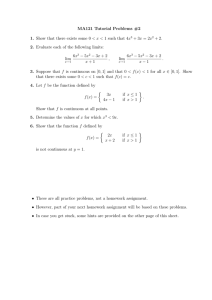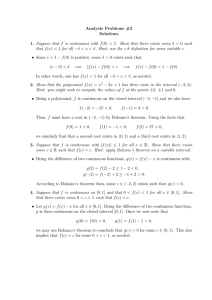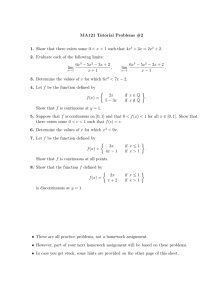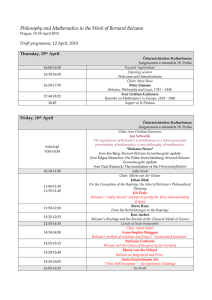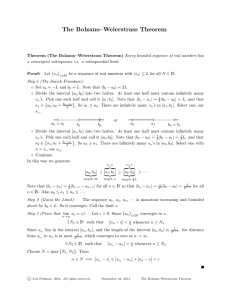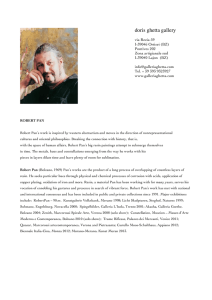Ground and Consequence in the Beytr¨ age Draft ∗
advertisement
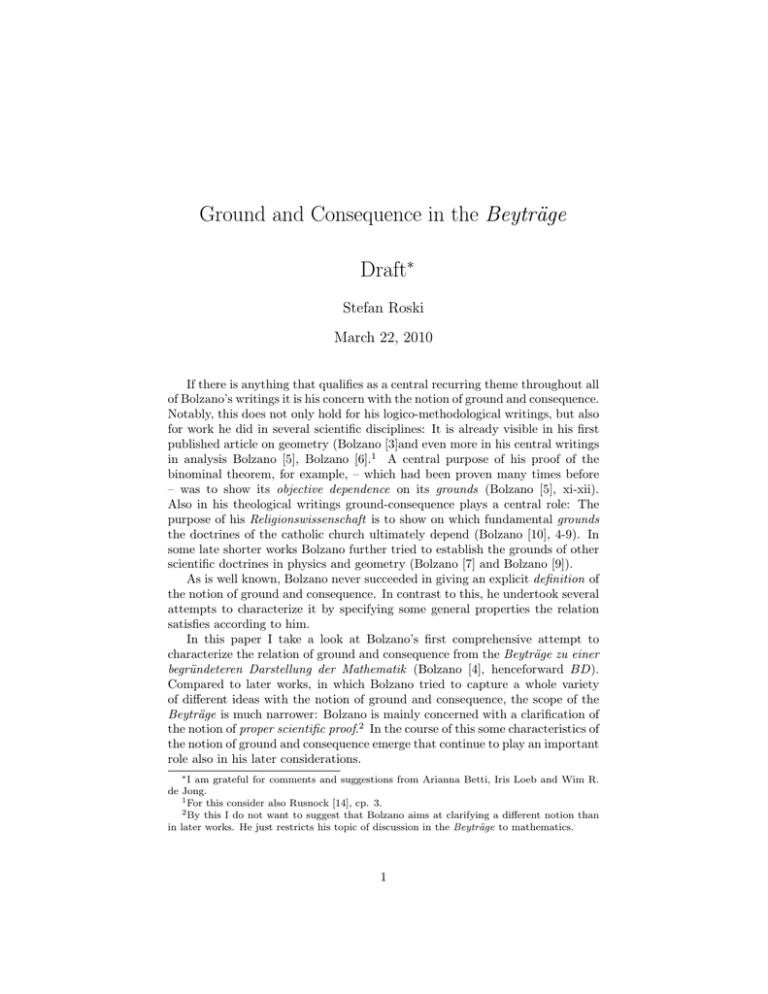
Ground and Consequence in the Beyträge Draft∗ Stefan Roski March 22, 2010 If there is anything that qualifies as a central recurring theme throughout all of Bolzano’s writings it is his concern with the notion of ground and consequence. Notably, this does not only hold for his logico-methodological writings, but also for work he did in several scientific disciplines: It is already visible in his first published article on geometry (Bolzano [3]and even more in his central writings in analysis Bolzano [5], Bolzano [6].1 A central purpose of his proof of the binominal theorem, for example, – which had been proven many times before – was to show its objective dependence on its grounds (Bolzano [5], xi-xii). Also in his theological writings ground-consequence plays a central role: The purpose of his Religionswissenschaft is to show on which fundamental grounds the doctrines of the catholic church ultimately depend (Bolzano [10], 4-9). In some late shorter works Bolzano further tried to establish the grounds of other scientific doctrines in physics and geometry (Bolzano [7] and Bolzano [9]). As is well known, Bolzano never succeeded in giving an explicit definition of the notion of ground and consequence. In contrast to this, he undertook several attempts to characterize it by specifying some general properties the relation satisfies according to him. In this paper I take a look at Bolzano’s first comprehensive attempt to characterize the relation of ground and consequence from the Beyträge zu einer begründeteren Darstellung der Mathematik (Bolzano [4], henceforward BD). Compared to later works, in which Bolzano tried to capture a whole variety of different ideas with the notion of ground and consequence, the scope of the Beyträge is much narrower: Bolzano is mainly concerned with a clarification of the notion of proper scientific proof.2 In the course of this some characteristics of the notion of ground and consequence emerge that continue to play an important role also in his later considerations. ∗ I am grateful for comments and suggestions from Arianna Betti, Iris Loeb and Wim R. de Jong. 1 For this consider also Rusnock [14], cp. 3. 2 By this I do not want to suggest that Bolzano aims at clarifying a different notion than in later works. He just restricts his topic of discussion in the Beyträge to mathematics. 1 The paper will be structured as follows: In the first part, I will present the account of ground and consequence given in BD. Bolzano tries to characterize the relation basically by specifying four rules of inference. After that I will point out some general properties that Bolzano wanted to capture with these rules. I will then establish the connection of those properties to a general picture underlying Bolzano’s conception of a proper science. Finally I will point out some connections of the account of the Beyträge to that of WL. 1 The account of the Beyträge The central topics of the Beyträge are mathematical method and mathematical presentation. Both topics are intimately connected to the notion of ground and consequence: [T]his much seems to me certain: in the realm of truth, i.e. the collection of all true judgements, a certain objective connection prevails, which is independent of our accidental and subjective recognition of it. As a consequence of this some of these judgements are the grounds of others and the latter are the consequences of the former. Presenting this objective connection of judgements and placing them one after another so that a consequence is represented as such and conversely, seems to me to be the real purpose to pursue in a scientific exposition. (BD, 39-40)3 The main purpose of a proper scientific presentation is to bring the connection between grounds and consequences to the fore. The connection, however, is independent of its presentation. It exists among – as one might say anticipating a distinction Bolzano introduced only later – true judgements as they are in themselves. Presenting the truths of a science such that they reflect this order is not merely a scholastic exercise. Bolzano stresses that it will frequently also provide insights into how further truths of the specific science are to be obtained – a trait which is lacking in those presentations that disregard the order of grounds and consequences and merely focus on certification (BD, 41).4 Presenting a certain truth such that its dependence on other truths is made explicit is the purpose of proper scientific proofs: [B]y a scientific proof of a truth [we understand] the representation of the objective dependence of it on other truths, i.e. the derivation of it from those truths which must be considered as the ground for it – not fortuitously, but actually [an sich] and necessary – while the truth it self, in contrast, must be considered as their consequence. (BD, 64) 3 Page references are to the German original, the English translations are all taken from Bolzano [11]. 4 In this sense one might say that the presenting the grounds of certain scientific doctrines has also a heuristic aspect. 2 For this reason, a taxonomy of those steps that are allowed in proper scientific proofs is at the same time a taxonomy of all “ways there are, in which one truth can be dependent on another truth” (BD, 64). In the following I will introduce and discuss the steps Bolzano listed in BD. Before that, however, I have to digress shortly into some details of the logical framework Bolzano was working with at that time. 1.1 The logic of the Beyträge In the Beyträge Bolzano thought the relation of ground and consequence to obtain among true judgements. By that time he did not yet distinguish explicitly between judgements understood as psychological events and their content – let alone did he have a specific ontological category for the contents of judgements. This creates some tensions that directly concern his remarks on ground and consequence. It is not clear how his talk of a “realm of truth” which is the collection of all true judgements and ordered independently of our subjective acknowledgement (BD, 39) is to be understood exactly. What does Bolzano mean by a judgement that is independent of the subjective acknowledgement of someone? In order to make sense of a lot of what Bolzano says it is in fact necessary to ignore the psychologistic framework of his logic or to assume at least that it is possible to speak about the content of a judgement that is independent of its acknowledgement. The constituents of judgements are intuitions (Anschauungen) and/or concepts (Begriffe), which Bolzano, following Kant, introduces as representations of something particular (in case of intuitions) or something general (in case of concepts) (BD, 12 and 138). Further, concepts can themselves be simple or complex. Complex concepts are composed by means of the connectives [which is] (as in ‘A triangle which is equiangular is equilateral’) or a term-conjunction5 (as in ‘Men are mortal and rational’), which Bolzano abbreviates by ‘cum’ and ‘et’ respectively. The general form of a definition (of the concept C) is accordingly: (A which is B)=C where A 6= C and B 6= C. Bolzano assumes that there are also simple concepts, which do not allow for explicit definition and have to be introduced by a procedure of ‘implicit’ definition (BT, 55).6 Whereas considerations on the relation between the content of a concept and its extension play an important part in the first volume of WL, Bolzano does not devote much space on this in BD. He explicitly underwrites a thesis he vigorously rejected later in WL (§64 therein), namely: if an object falling under a concept is complex, the concept must be complex as well (BD, 44). There is thus a certain correspondence between the mereological properties of objects and of concepts representing them. Except from this thesis, however, it is unclear 5 How exactly Bolzano wanted this term-conjunction to be understood is not clear. I will point out some difficulties below. 6 For a discussion of Bolzano’s account of implicit definition see Rusnock [14], 53-4. 3 how Bolzano viewed the relation between the content and extension of concepts. Although, he explicitly distinguishes the parts a concept is composed of and its width (Weite) (roughly: the number of objects falling under it) (BD, 105)7 , he sometimes seems to confuse both. He claims, for example, that expressions like ‘S is a kind of P ’, ‘S contains the concept P ’ and ‘the concept P belongs to [kommt zu] the thing S’, amount to the same (BD, 74), although some of them seem to make statements about conceptual containment and others about objects falling under concepts. It seems, however, reasonable to assume that Bolzano understood statements like ‘A is a kind of B’ and all other forms he deems equivalent to this analogous to ‘All As are Bs’8 and I will do so in the following. Every judgement consists of a subject concept, a predicate concept and a copula. Bolzano distinguishes five different copulae and classifies the judgements accordingly (BD, 74-76): 1. A contains the concept or is a kind of B, as in necessary judgements.9 2. A is B is possible or A can be B, as in possibility judgements. 3. A ought to do B, as in prescriptive judgements. 4. I perceive X, as in actual or empirical judgements. 5. A is probably B 10 . According to Bolzano, mathematics contains only the first two types of judgements (BD, 110) and he restricts his considerations concerning ground and consequence explicitly to those. 1.2 Ways of being objectively dependent As noted above, Bolzano’s method of introducing the relation of ground and consequence in BD consists basically in giving a list of rules, which codify ways in which (collections11 of) truths can depend on one another. He considers in total four rules without claiming that this list is complete. In each instance of a rule a collection of two premises forms ground for the respective conclusion, 7 See also his discussion of the ambiguity of the German ‘enthalten’ and its French equivalent in the discussion of Selle’s account of analyticity (BD, p. 111). Bolzano observes that one cannot ‘infer’ the width of a concept from its complexity. He acknowledges that several simple concepts may be sub-ordinated of each other, i.e. differ in width: “not every concept which is subordinated to a more general one ceases therefore to be simple” (BD, 47). This seems to be some evidence for the thesis that he did not subscribe to the Canon of Reciprocity, i.e. the thesis that increasing complexity of a concept goes hand in hand with decreasing generality. 8 In the sense that both statements are true at the same time. 9 Bolzano did not consider both linguistic forms to express different concepts. In the following I will use the term ‘is’ to denote this concept. 10 On these Bolzano did not have a settled opinion in BD 11 Bolzano explicitly calls both premisses of (I) an ‘Inbegriff ’ of two sentences (BD. 66). I take it that he would do so also in all other rules he considers. 4 which is in turn their consequence (BD, 69). The rules are as follows:12 A is M ; A is N (I) A is (M et N ) M is B ; N is B (II) (M et N ) is B M is B ; M can be N (III) (M cum N ) is B A is M ; M is B (IV ) A is B Form (III) may be in need of some comments. Bolzano considers this rule as a kind of ‘weakening’ of the following form (which, in turn, is a special case of rule (IV)): M is B ; (M cum N ) is M (III ∗ ) (M cum N ) is B in the sense that in order to obtain the second premise of (III∗ ), one first has to show that the second premise of (III) holds. And if one has shown the latter, one can omit the former as a “merely” analytic sentence and thus stick with (III) (BD, 67). Not every judgement allows of proof by (I)-(IV). Bolzano assumes that there have to be fundamental truths, which do not depend on others and are thus not provable.13 It is clear that no judgement that contains either a complex concept or a complex predicate can be a fundamental truth (BD, 88-9), for otherwise it would be provable by one of rules (I)-(III). However, a simple judgement may still be proven by rule (IV). An interesting corollary that Bolzano derives from his characterization of fundamental truths is that no analytic truth can be fundamental, i.e. an analytic truth can never be an axiom of a science (BD, 81).14 Bolzano undertakes quite interesting considerations on how fundamental truths might be known, which I cannot discuss in this context.15 12 I will use ‘is’ to abbreviate ‘is a kind of’ and ‘is contained in’ which Bolzano takes to be to denote the same concept 13 His argument is basically that otherwise there would be infinite chains of dependence, which he deems an incoherent conception (BD, 69-70). Of course, unless he has somehow shown that his list of rules is complete, Bolzano cannot exclude that there might be other rules by which a judgement that is improvable by (I)-(IV) can be proven. However, I will ignore this complication in the following. 14 In BD Bolzano still assumed a Kantian notion of analyticity: “[A]n analytic judgement is such that the predicate is contained directly, or indirectly, in the definition of the subject.” (BD, 80) Thus, analytic truths are all of the form [(A which is B) is B]. 15 For a discussion, see Rusnock [14], Ch. 2.4 5 2 Properties of ground and consequence in the Beyträge The rules (I)-(IV) are of little intrinsic interest. It is only some general properties they exhibit according to Bolzano that makes their point vivid. In particular, Bolzano demands that in proper scientific presentations (i) truths that appear as grounds should be (in some sense) more general and less complex than their consequences, (ii) scientific proofs should neither contain redundancies nor “crossing of kinds”, and (iii) scientific proofs should be unique. His rules are supposed to assure precisely those properties to obtain. An example of a rule that violates the first condition is the following: A is (B cum C) (@) A is B, A is C . Bolzano comments on (@): I do not think that this is an inference in that sense of the word we established at the beginning of the section [i.e. an inference that represents a way in which truth may be dependent on one another]. Having recognized the truth of the first of these three propositions, I can, indeed, recognize subjectively the truth of the two others, but I cannot view the first objectively as the ground of the two others. (BD, 68) I will discuss all three conditions in the following. 2.1 (i) Simplicity and generality According to Bolzano, the truths of a science depend on each other in such a way that simple truths precede complex ones and general ones precede narrow ones. In particular, he poses two conditions: (BT-1) “If several sentences appearing in a scientific system have the same predicate, then the one with the narrower subject must follow the one with the wider subject, and not conversely.” (BD, 102) (BT-2) “If several propositions appearing in a scientific system have the same subject then the proposition with the more composite predicate must follow that with the simpler predicate and not conversely.” (BD, 104)16 And indeed (I)-(IV) assure that both conditions will be satisfied: If there are two propositions [S is P ] and [S 0 is P ], where S 0 is narrower than S, then, argues Bolzano, S 0 will either be a kind of S, in which case [S 0 is S] holds, 16 Although he does not state it explicitly, it is clear that the rules also yield a second property: the subject of the conclusion in a proper scientific proof will never be less complex than the subject of either of its premisses. 6 or S 0 will be definable (together with some concept X) and thus of the form (S cum X) (BD, 102). In the first case [S 0 is P ] will be provable by the following instance of rule (IV) S is P , S 0 is S S 0 is P , in the second case by the following instance of (III) S is P, S can be X S 0 (= (S cum X)) is P . One might add that if S 0 is of the form [(S et X)] then it will be provable by (II). (BT-2) is also obviously satisfied. There is no way in which the complexity of a predicate can decrease by applying either of the rules. Bolzano carefully notes that one cannot demand that a narrower predicate shall never appear before a general one, since, e.g., in proofs of type (IV) there will have to occur a predicate narrower than that of the conclusion before it, i.e. a judgement with a narrower predicate will have to be proven before a more general judgement. (BT-1) and (BT-2) show why Bolzano cannot admit rule (@) in a scientific proof. The predicate of its premise is more complex than the predicate of either of its conclusions and thus (BT-2) is violated. Conditions (BT-1) and (BT-2) give rise to some questions. What is the relation of both conditions to each other? In particular: If there are two sentences p and q, such that p has a narrower subject than q and q a more complex predicate than p, can the former be the ground of the latter or conversely? Bolzano does not give an answer to this in BD. In his later Bolzano [8], however, he clearly states that lower complexity can overrule generality (Bolzano [8], 80) in the sense that a narrower proposition has to occur before a more general one if the narrower proposition is more complex. It seems reasonable that the Bolzano of BD would give the same answer. The point of giving more weight to complexity than to generality seems to be clear: Bolzano wants to assure that propositions containing defined concepts do not occur as ground of propositions containing undefined concepts – even if the undefined concepts may be narrower. 2.2 (ii) Kind crossing and redundancy One of the most important methodological aims of Bolzano was to exclude proofs that involve “kind crossing”, i.e. use concepts from an alien domain in scientific proofs. One of the ever-recurring themes in his work is criticism of proofs of theorems from analysis that make use of geometrical concepts (see for this the introductions to Bolzano [6] and Bolzano [5]). In BD he tries to pin down this fallacy to a simple property: Proofs involving “kind crossing” have, according to him, the characteristic that at least one of the mediate concepts occurring 7 in them is narrower than the subject of the conclusion (BD, 117).17 Properly scientific proofs should, thus, not violate the following condition (KC) The mediate concepts used in a proof must not be narrower than the subject of its conclusion. (BD, 110) A related vice a proof can have is containing redundant elements. This happens, according to Bolzano, if the mediate concept used in it is wider than the predicate of the conclusion. To avoid this, the proofs have to satisfy the following condition: (RD) The mediate concepts used in a proof must not be wider than the predicate of its conclusion (BD, 110).18 Now, Bolzano tries to show that redundant proofs and proofs that involve “kind crossing” are formally impossible given his rules via a case by case consideration. For this to work he has to assume the following: (SP) The predicate in all affirmative necessary judgements and in all affirmative possibility judgments will be wider than the subject (BD, 110-1). Given this it is clear that rules (III) and (IV) conform to (KC) and (RD). Since the predicate of a judgement must always be wider than its subject, it is impossible to “cross kinds” or to have a proof containing redundancies. However, Bolzano’s attempts to show that rules (I) and (II) satisfy (KC) and (RD) give rise to problems. In particular, the interpretation of the connective et turns out to be unclear. In the first rule A is M ; A is N (I) A is (M et N ) the mediate concepts are M and N . According to (RD), those should be narrower than the predicate of the conclusion – (M et N ) – and according to (KC) wider than its subject A. This implies that (M et N ) must be wider than both M and N (BD, 114). This, however, can only be the case if et works analogous to the set-theoretic union operation: Everything that falls under M and everything that falls under N together falls under (M et N ). So far, so clear. But this interpretation of et does not work for the second rule: M is B ; N is B (II) (M et N ) is B Here, again, the predicate of the conclusion should be wider than the mediate concepts M and N (according to (RD)) and the mediate concepts should be wider than the subject (according to (KC)), which is (M et N ) in this case (BD, 114). But if both M and N shall be wider than (M et N ) then et cannot be 17 Mediate concepts are those concepts that appear in the premises of the rules, but not in the conclusion (except as parts of other concepts). 18 Bolzano extends his considerations also to proofs that contain negative judgements, I will ignore these in the following. 8 interpreted analogous to the set-theoretic union-operation. In this case only an interpretation of et analogous to the set-theoretic intersection operation seems to make sense. Everything that falls both under M and N also falls under (M et N ). This result is highly problematic for Bolzano. If et is supposed to be interpreted uniformly, Bolzano’s conditions cannot be satisfied. In particular, if et works like the union operation, rule (II) violates Bolzano’s condition (BT-1): the conclusion of a proper scientific proof will have a wider subject than each of its premises (having the same predicate). On the other hand: if et works like the intersection operation, condition (RD) will be violated in case of rule (I): there will be mediate concepts wider than the predicate of the conclusion. So under the assumption that et shall always denote the same concept in all rules (and Bolzano does not say anything that would speak against this), not both conditions (BT-1) and (RD) can be upheld. If et works like intersection, (RD) has to go, if it works like union (BT-1) has to. Unfortunately, in BD one does not find evidence for either case. A look to WL might help to clarify this issue: the way Bolzano interprets the term-conjunction in WL (denoted by ‘+’) is clearly analogous to the intersection operation.19 In this case, however, Bolzano cannot demand (RD). To keep (RD) Bolzano had to interpret et differently depending on where it occurs in a judgement. I won’t discuss both options at this place, but merely note that the idea of capturing properties like redundancy solely by simple conditions on the mediate concepts used in a proof is problematic in any case, because, as Bolzano came to realize in later works, there might be admissible steps in scientific proofs, which to not use mediate concepts at all. 2.3 (iii) Uniqueness Another property Bolzano takes scientific proofs to have is uniqueness in the sense that for each provable judgement, there is at most one scientific proof. There might be different linguistic expressions of one and the same proof, but if one regards as what is essential in a proof as lying in those judgements upon which the [conclusion] to be proved rests, as a consequence to its ground, then for every judgement there is only one single proof. (BD, 119) Again, Bolzano takes his rules to assure this property: If there seem, for example, to be two proofs for a given judgement [A is B], they will have to proceed by using certain mediate concepts M and N (where M 6= N ). But in this case either M will be subordinated to N or otherwise. In either case there will be a proof that makes use of the truth [M is N ] or [N is M ] (BD, 120). To give an example, let ‘w(A)’ denote the width of A. And let w(A) < w(M ) < w(N ) < w(B) then A is B can be proven by two different applications of rule (IV): 19 See for example WL II, 444-5. 9 A is M ; M is B A is N ; N is B A is B and A is B However, one premise of the second one – [A is N ] – will again be provable using the truth [M is N ]. And thus Bolzano writes: So in other words there must be as many syllogisms [i.e. rules of form (IV)] put forward as there are intermediate concepts between A and B. And since there is obviously only a single definite number of these intermediate concepts, then also the number and form of these syllogisms, and therefore the whole proof, is determined. (BD, 121) In order to assure uniqueness, Bolzano has to demand that in a proper scientific proof each step has to be the smallest possible step. 3 The general picture Despite the programmatic character of Bolzano’s account in the Beyträge, there is a quite neat picture underlying it. In fact the picture emerges from the conditions I discussed above: The relation of ground and consequence orders a given collection of truths such that a certain number of simple truths is followed in a succession of smallest logically valid20 steps by ever more complex ones. In this way a certain domain of objects is characterized in an ever more specific way starting from unprovable simple truths by way of introducing definitions and proving further truths from them.21 All this conforms precisely to the Classical model of scientific rationality, as it is described e.g. in Betti and de Jong [2].22 And it is a conception that Bolzano still held within WL: When it is said that the genuinely scientific presentation proceeds from the general to the particular, from the simpler to the more general, this is surely advanced only because the more general, simpler truths are conceived to be the ground of the particular and more complex. (WL II, 388) What’s more: in the BT the connection of the relation of ground and consequence to methodological aims of Bolzano is crystal clear. Proper scientific 20 To be clear: Bolzano did not have an explicitly defined concept of logical consequence in BD, but it is obvious that (I)-(IV) are intended to be logically valid in an intuitive sense. Further, each instance of a rule is valid in the sense that the conclusion is derivable from the premisses with respect to the non-logical concepts occurring in it (in the sense of W L, §155). 21 This raises, of course, the question of how the domain of a science can be specified. Presumably, Bolzano thought of certain primitive concepts such as that of a number, that of a point etc. as specifying the respective domains of several sciences (or subsciences). Evidence for this is given by his classification of mathematics, in which the notion of geometry occurs as a subscience, which treats of objects in space. Now, the most general concept referring to objects in space is that of a point. (BD, 47-8). 22 And applied to Bolzano in de Jong [12] and de Jong [13] and to Bolzano’s theory of ground and consequence especially in Betti [1]. 10 proofs must not allow kind crossing and must be such that they do not contain any redundancies. What is especially remarkable is that Bolzano seems to think that these traits can be captured in an entirely ‘formal’ way. The condition of uniqueness assures further that no step can go unnoticed. In an almost ‘formalistic’ way, Bolzano even assumes that each mathematical proof can be ultimately analyzed into simple proof steps that correspond to his rules (I)-(IV) (BD, 118).23 4 An outlook on later developments In what way might the account developed in the BD be relevant for Bolzano’s later work? Since Bolzano obviously aims at characterizing sciences as structures that are independent of the subjective acknowledgement of particular subjects, it might seem that the whole psychologistic ontology underlying his account in BD creates serious problems. However, it turns out that Bolzano could retain a great deal of the methodological insights of the BD in later works, in which he abandoned the psychologistic framework, which shows that the framework is after all inessential to his account. Still there is something odd about the approach in BD. The fact that Bolzano characterizes the relation of ground and consequence merely by a list of rules naturally leads to the question of whether this list is complete and how to decide whether it is. And, indeed, a look in WL shows that he came to realize later on that much more inferential steps are admissible in scientific proofs (see, e.g. WL II, 399 and 407). Given the fact that all rules of BD are logically valid, a natural extension of the approach would be to characterize the relation as a special case of Bolzano’s relation of derivability. In fact, in W L Bolzano considered the idea of capturing the notion with his concept of strict derivability (WL, §155,30), which forms, in a way, a generalization of the notion of smallest proof-step. Moreover, he tried to combine this with conditions of generality and simplicity, which are similar to those given in BD (W L, §221). In this way he even came close to a definition of the notion of ground and consequence in terms of derivability and a simplicity condition (cf. the note to §221 of W L). This shows that the ideas developed in the Beyträge are crucial also for Bolzano’s later account.24 In the WL Bolzano discussed two problematic cases for a definition of ground and consequence in terms of (strict) derivability and simplicity and generality. One is concerned with propositions containing intuitions (WL, §221,2) and the other with propositions containing the concept of ought (WL, §200). The importance of these problematic cases for the general account is not easy to assess and has to be left open for further research.25 23 Again, as Bolzano acknowledges, there might be more admissible rules that (I)-(IV). supports the account of Bolzano’s theory of ground and consequence given by Betti [1], part 4. 25 A detailed account of the second problem (propositions containing the concept ought) is given in Betti [1]. 24 This 11 References [1] A. Betti. Explanation in metaphysics and Bolzano’s theory of ground and consequence. Logique et Analyse, forthcoming, 2010. [2] A. Betti and W. de Jong. The Classical Model of Science. A Millenia-old Model of Scientific Rationality. Synthese, doi: 10.1007/s11229-008-9420-9, 2008. [3] B. Bolzano. Betrachtungen über einige Gegenstände der Elementargeometrie. Karl Barth, Prag, 1804. [4] B. Bolzano. Beyträge zu einer begründeteren Darstellung der Mathematik. Caspar Widtmann, Prag, 1810. [5] B. Bolzano. Der binomische Lehrsatz, und als Folgerung aus ihm der polynomische, und die Reihen, die zur Berechnung der Logarithmen und Exponentialgrössen dienen, genauer als bisher erweisen. Enderssche Buchhandlung, Prag, 1816. [6] B. Bolzano. Rein analytischer Beweis des Lehrsatzes, daß zwischen je zwey Werthen, die ein entgegensetztes Resultat gewaehren, wenigstens eine reelle Wurzel der Gleichung liege. Gottlieb Haase, Prag, 1817. [7] B. Bolzano. Versuch einer objektiven Begründung der Lehre von der Zusammensetzung der Kräfte. Abhandlung der königlich böhmischen Akademie der Wissenschaften, 5(2):425–464, 1843. [8] B. Bolzano. Von der mathematischen Lehrart. In J. Berg, editor, Bernard Bolzano Gesamtausgabe, Reihe 2A, Bd. 7. Frommman-Holzbog, Stuttgart Bad-Cannstatt, 1975/1833-41. [9] B. Bolzano. Versuch einer objektiven Begrüdung der Lehre von den drei Dimensionen des Raumes. In G. Gabriel, editor, Bernard Bolzano Gesammtausgabe, Reihe 1, Bd. 18. Frommman-Holzbog, 1989/1843. [10] B. Bolzano. Lehrbuch der Religionswissenschaft. In J. Louzil, editor, Bernard Bolzano Gesamtausgabe, Reihe 1, Bd. 6-8. Frommman-Holzbog, 1994/1834. [11] B. Bolzano. Contributions to a Better-Grounded Presentation of Mathematics. In S. Russ, editor, The Mathematical Works of Bernard Bolzano, pages 83–138. Oxford University Press, Oxford and New York, 2004/1810. [12] W. de Jong. Bernard Bolzano, Analyticity and the Aristotelian Model of Science. Kant Studien, 92(3):328–349, 2001. [13] W. de Jong. The Analytic-Synthetic Distinction and the Classical Model of Science: Kant, Bolzano and Frege. Synthese, doi: 10.1007/s11229-0089420-9, 2008. 12 [14] P. Rusnock. Bolzano’s Philosophy and the Emergence of Modern Mathematics. Rodopi, Amsterdam, 2000. 13


